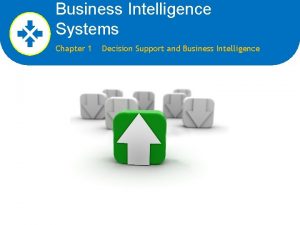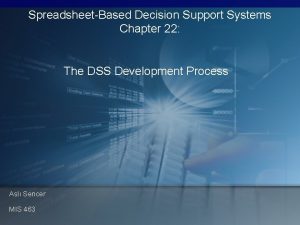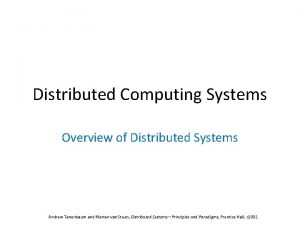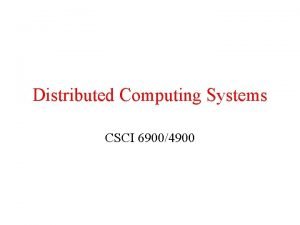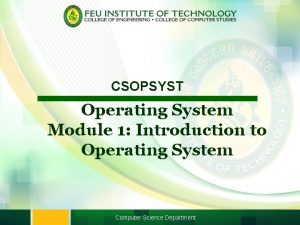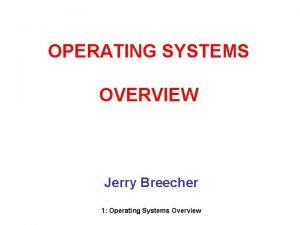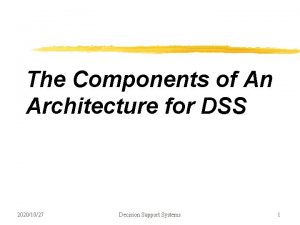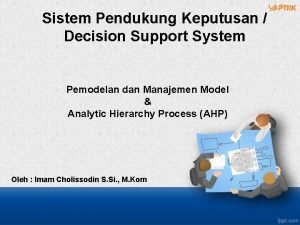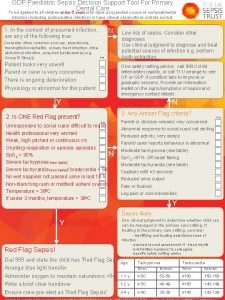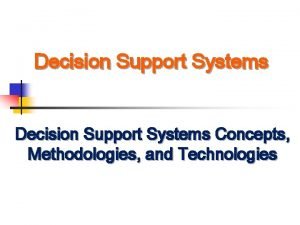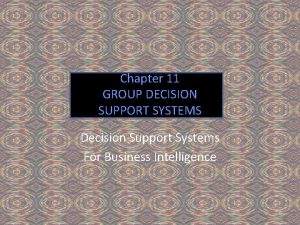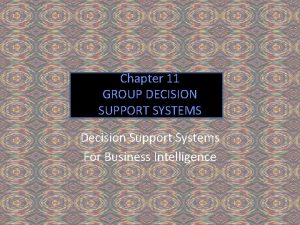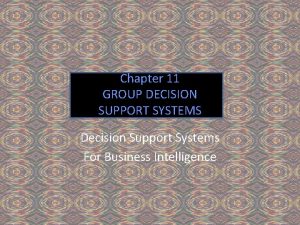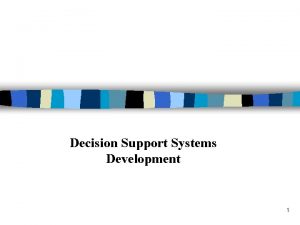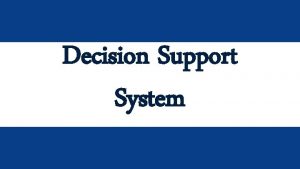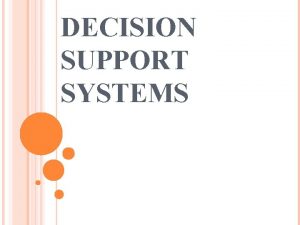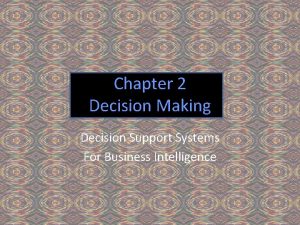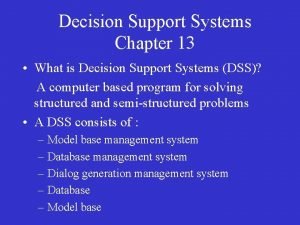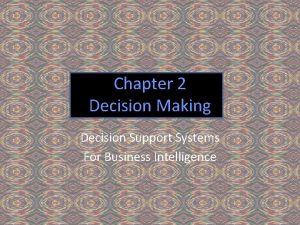CHAPTER 3 DECISION SUPPORT SYSTEMS AN OVERVIEW Decision


























- Slides: 26

CHAPTER 3: DECISION SUPPORT SYSTEMS: AN OVERVIEW Decision Support Systems and Intelligent Systems, 7 th

Learning Objectives Understand possible decision support system (DSS) configurations Understand the key differences and similarities between DSS and business intelligence (BI) systems Describe DSS characteristics and capabilities Understand the essential definition of DSS Understand DSS components and how they integrate

Review Definitions of DSS DEF 1: DSS as extendible systems capable of supporting ad hoc data analysis and decision modeling, oriented toward future planning, and used at irregular, unplanned intervals. DEF 2: DSS as a computer-based system consisting of three interacting components: 1 -a language system (a mechanism to provide communication between the user and other components of the DSS), 2 -a knowledge system (a repository of problem domain knowledge embodied in DSS as either data or procedures), 3 -and a problem-processing system (a link between the other two components, containing one or more of the general problemmanipulation capabilities required for decision making). DEF 3: DSS is situations where a 'final' system can be developed only through an adaptive process of learning and evolution. "

DSS Configurations The configuration of decision support systems depends on the nature of the management-decision situation and the specific technologies used for support These technologies are assembled from four basic components � Data � Models � User interface � Knowledge (optional) these components are assembled defines their major capabilities and the nature of the support provided.

DSS Configurations DSS configuration has the following characteristics: It supports individual members and an entire team. It is used repeatedly and constantly. It has three major components: data, models. and a user interface. It uses subjective(based), personal, and objective data. It is used in the private sector. It helps the user to make faster, smarter, better decisions.

DSS Application And BI A DSS application is an approach (or methodology) for supporting decision-making. It uses an interactive, flexible, adaptable CBIS especially developed for supporting the solution to a specific nonstructured management problem. It uses data, provides an easy user interface, and can incorporate the decision-maker's own insights (e. g. , a scheduling system for a specific company) CBIS=Computer Based information system

DSS Application and BI Business intelligence (BI) is a collection of technical and process innovations across the data warehousing and business intelligence space Business analytics The application of models directly to business data. Business analytics involves using DSS tools, especially models, in assisting decision makers. It is essentially OLAP(Online Analytical Processing )/DSS. Predictive analytics A business analytical approach toward forecasting (e. g. , demand, problems, opportunities) that is used instead of simply reporting data as they occur

DSS Characteristics and Capabilities

Components of DSS 1 -Data management subsystem � Consists, generally, of database that contains relevant data for the situation and is managed by software called DBMS which can be connected with the corporate data warehouse 2 -Model management subsystem � Consists of financial, statistical, management science or other quantitative models that provides the DSS system analytical capabilities 3 -User interface subsystem � The component of a computer system that allows bidirectional communication between the system and its user

Components of DSS 4 -Knowledge-based management subsystem (optional) � The knowledge-based management subsystem can support any of the other subsystems or act as an independent component � Organizational knowledge base An organization’s knowledge repository

Data Management Subsystem 1. The Database: is a collection of interrelated data organized to meet the needs and structure of an organization and can be used by more than one person for more than one application Internal data come mainly from the organization’s transaction processing system External data include industry data, market research data, census(register) data, regional employment data, government regulations, tax rate schedules, and national economic data Private data can include guidelines used by specific decision makers and assessments of specific data and/or situations

Data Management Subsystem Data organization: fully integrated DSS database vs. separate database � Data extraction: the process of capturing data from several sources, synthesizing them, summarizing them, determining which of them are relevant, and organizing them, resulting in their effective integration Database management system (DBMS) software for establishing, updating, and querying (e. g. , managing) a database � 2. Extracts data Manages data and their relationships Updates (add, delete, edit, change) Retrieves data (accesses it) 3. Directory a catalog of all the data in a database or all the models in a model base 4. Query Facility the (database) mechanism that accepts requests for data, accesses them, manipulates them, and queries them

Data Management Subsystem

The Model Management Subsystem Five main parts in The Model Management Subsystem 1. Model base A collection of preprogrammed quantitative models (e. g. , statistical, financial, optimization) that provide analysis capabilities � five categories of models in the model base Strategic models Tactical(planned) models Operational models Analytical models Model building blocks and routines The ability to invoke, run, change, combine and inspect models is a KEY DSS capability

The Model Management Subsystem Strategic models: Models that represent problems for the strategic level (i. e. , executive level) of management Tactical models: Models that represent problems for the tactical level(planned) (i. e. , midlevel) of management Operational models: Models that represent problems for the operational level of management Analytical models: Mathematical models into which data are loaded for analysis Model building blocks and routines: Preprogrammed software elements that can be used to build computerized models. For example, a random-number generator can be employed in the construction of a simulation model

The Model Management Subsystem 2. Modeling tools (Modeling language) 3. Model base management system: MBMS software has six main functions � Model creation, using programming languages, DSS tools and/or subroutines, and other building blocks � Generation of new routines and reports � Model updating and changing � Model data manipulation � Model execution � Model integration

The Model Management Subsystem 4. Model directory Catalog of all the models and other software in the model base. It includes: � Model definition � Model’s Main function � Answers of questions about the availability of and capability of the models 5. Model command Processor: accepts and interprets the instruction, and routes them from the user interface component to the MBMS

User Interface (Dialog) Subsystem User interface: The component of a computer system that allows bidirectional communication between the system and its user. � Most important component in any DSS!!Why? User interface management system (UIMS) The DSS component that handles all interaction between users and the system DSS user interfaces access is provided through Web browsers including: � Voice input and output � Portable devices � Direct sensing devices

Knowledge-Based Management Subsystem Advanced DSS are equipped with a component called a knowledge-based management subsystem that can supply the required expertise for solving some aspects of the problem and provide knowledge that can enhance the operation of other DSS components

The User The person faced with a decision that an MSS is designed to support is called the user, the manager, or the decision maker MSS has two broad classes of users: managers and staff specialists � Staff specialists use the system much more frequently than manager and tend to be more detail-oriented � Staff analysts are often intermediaries between managers and the MSS

The User Intermediary A person who uses a computer to fulfill requests made by other people (e. g. , a financial analyst who uses a computer to answer questions for top management) Staff assistant An individual who acts as an assistant to a manager Expert tool user A person who is skilled in the application of one or more types of specialized problem-solving tools Business (system) analysts An individual whose job is to analyze business processes and the support they receive (or need) from information technology Facilitators (in a group support systems GSS) A person who plans, organizes, and electronically controls a group in a collaborative computing environment

DSS Hardware affects the functionality and usability of the MSS The choice of hardware can be made before, during, or after the design of the MSS software Major hardware options: � Organization’s servers � Mainframe computers with legacy DBMS, � Workstations � Personal computers � Client/server systems

DSS Hardware Portability has become critical for deploying decision-making capability in the field, especially for salespersons and technicians The power and capabilities of the World Wide Web have a dramatic impact on DSS � Communication and collaboration � Download DSS software � Use DSS applications provided by the company � Buy online from application service providers (ASPs)

DSS Classifications Alter’s output classification: based on the Degree of action implication ( conclusion )of system out-puts" or the extent to which system outputs can directly support the decision Seven Categories � Data File drawer systems Data analysis systems � Data or models Analysis information systems � Models Accounting models Representational models Optimization models Suggestion models

DSS Classifications Holsapple and Whinston’s classification classify DSS into the following six frameworks � Text-oriented DSS � Database-oriented DSS � Spreadsheet-oriented DSS � Solver-oriented DSS � Rule-oriented DSS

DSS Classifications Other DSS categories � Institutional DSS A DSS that is a permanent fixture in an organization and has continuing financial support. It deals with decisions of a recurring(habit or frequent) nature � Ad hoc DSS A DSS that deals with specific problems that are usually neither predictable nor recurring � Personal support � Group support � Organizational support
 Decision support systems and intelligent systems
Decision support systems and intelligent systems Decision support and business intelligence systems
Decision support and business intelligence systems Developing spreadsheet-based decision support systems
Developing spreadsheet-based decision support systems Decision support and business intelligence systems
Decision support and business intelligence systems Decision support system vs expert system
Decision support system vs expert system Objectives of decision making
Objectives of decision making Investment decision financing decision dividend decision
Investment decision financing decision dividend decision Freestylelibre.us/support/overview.html
Freestylelibre.us/support/overview.html Distributed systems overview
Distributed systems overview Sap project systems overview
Sap project systems overview Distributed systems overview
Distributed systems overview I/o device management in operating system
I/o device management in operating system Operating systems overview
Operating systems overview Chapter 2 economic systems and decision making answer key
Chapter 2 economic systems and decision making answer key Chapter 2 economic systems and decision making
Chapter 2 economic systems and decision making Chapter 2 economic systems and decision making
Chapter 2 economic systems and decision making Major and minor supporting details examples
Major and minor supporting details examples Types of information systems
Types of information systems Components of decision support system
Components of decision support system Contoh spk motor honda
Contoh spk motor honda Navify decision support
Navify decision support Gdp sepsis decision support tool
Gdp sepsis decision support tool Components of decision support system
Components of decision support system Gdss
Gdss Mdm support technologies in dss
Mdm support technologies in dss Data management subsystem in dss
Data management subsystem in dss Components of decision support system
Components of decision support system

